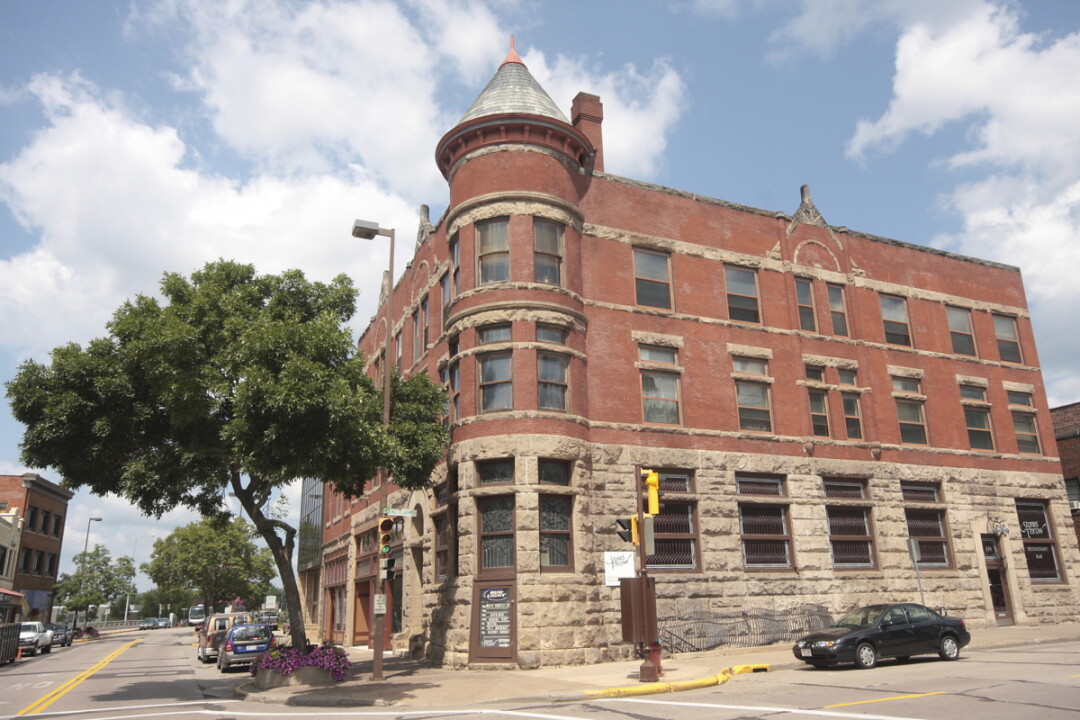The Rest Is History
flip through Eau Claire's historic structures in new book
Barbara Arnold, photos by Andrea Paulseth |

When I was a little girl growing up in Eau Claire, our family went on Sunday afternoon drives.
Sometimes, my grandpa Arnold drove my brother Dean and me. One time, he drove us south of town to a hill where there was a huge barn. I played in the hayloft, while he and Dean walked around. When I returned to Eau Claire in 2004, I met the darling – and now 90 years young – Dottie Carpenter (née Bullis), in whose family’s barn I’d played. Now what used to be the Bullis Farm is the Holiday Inn, Oakwood Mall, and strip shopping malls and restaurants.
Other times, my dad or Uncle Dave would drive us (my mom, my brother, my Aunt Marjorie, my cousin Dave, and me) in the station wagon. The adults had grown up in Eau Claire, plus my aunt and uncle were history teachers, so these drives became living history lessons.
“Historic structures are reminders of a city’s culture and complexity. They provide a very visual physical connection to our past and cultural identity. Historic architecture helps to provide a ‘spirit’ of a place and can draw people – tourists and residents – to neighborhoods and provide a boost to the local economy.” – Carrie Ronnander, director, Chippewa Valley Museum
As we drove by house after house, I’d hear who lived where, when, and how they were “related” to my other grandfather, a family doctor; and his father, a scaler with the Daniel Shaw Lumber Co. My mom often recounted traveling by horse and buggy from her family’s home in Randall Park to her grandparents’ farm, southwest of Eau Claire, on what was a dusty dirt road, now Highway 37.
My aunt Marjorie Barnes was listed as one of many contributors to the first edition of Eau Claire Landmarks: Designated Historic Properties in Eau Claire, Wisconsin, published in 1986. That 49-page booklet had a brown-toned image of the David Drummond House, 1310 State St., on its cover.
The second Eau Claire Landmarks book was published in 2002 with a full-color photo of the James Barber House, 132 Marston Ave., on the front and back covers.
Debuting this May (which happens to be National Historic Preservation Month) was the third edition of Eau Claire Landmarks: Designated Historic Properties in Eau Claire, an update of the 2002 edition. A full-color photo of the George Coghlan House, 606 Fourth Ave., spans the cover.
While many of the narratives are naturally retained from the earlier editions, what’s new and delightful about this latest edition is that all the photos are beautifully shot in living color on sunny days during summer or early fall, before the snow flies. These photos are largely due to the efforts of City of Eau Claire City Planner Patrick Ivory and pro bono project intern Nicholas Kayser, who was then a candidate for a master’s degree in history at UW-Eau Claire. (He graduated in December.)
Kayser did all of the research of the new narratives at a desk in the Chippewa Valley Museum, where he had ready access to its massive archives. He relied on a number of sources, including the Intensive Historical/Architectural Survey of the City of Eau Claire, Wisconsin, by Mary Taylor (1983), and The Rivers Flow On, by local historian Lois Barland (1965).
 The Eau Claire Landmarks book is published under the auspices of the City of Eau Claire Landmarks Commission, a seven-member citizen board appointed by the City Council. According to the City of Eau Claire’s Historic Preservation webpage, the Landmarks Commission is charged to: “1) encourage the preservation of our remaining landmark properties; 2) to assist in the stabilization and maintenance of the City’s older neighborhoods; and 3) to provide educational activities which foster an appreciation of Eau Claire’s heritage.”
The Eau Claire Landmarks book is published under the auspices of the City of Eau Claire Landmarks Commission, a seven-member citizen board appointed by the City Council. According to the City of Eau Claire’s Historic Preservation webpage, the Landmarks Commission is charged to: “1) encourage the preservation of our remaining landmark properties; 2) to assist in the stabilization and maintenance of the City’s older neighborhoods; and 3) to provide educational activities which foster an appreciation of Eau Claire’s heritage.”
John Mann, a history professor who specializes in public history at the UW-Eau Claire, is the current chairman of the Landmarks Commission. Mann grew up in Spokane, Wash., where his parents loved to buy older homes and restore them. So by virtue of his parents’ lifestyle, he has an innate appreciation for historic preservation. A preservation planner for the City of Spokane, he later became a professor at Gonzaga University, before coming to Eau Claire in the early 2000s to teach here.
“For a city of its size, Eau Claire has a remarkable number of homes, properties, and structures that contribute to distinctive historic districts,” Mann shared. “One of my favorites is the Charles L. James House at 411 Union St. It’s not a grand mansion. Rather, it’s a simple Victorian cottage, and recognized due to the man who lived there and his contribution to the anarchist movement in the United States.”
The book features properties and districts that are either designated on the National or Local Historic Registers or identified as eligible for either of these two registers, according to Ivory. “These properties have to be designated by the Wisconsin Historical Society and are important either for historical events or persons associated with the building, or because they are significant architecturally,” Ivory said. “Local designations generally include the National and State properties, but also include properties that only have local significance.”
Why preserve the past in the face of progress and modernity in today’s world?
“Historic structures are reminders of a city’s culture and complexity,” said Carrie Ronnander, director of the Chippewa Valley Museum. “They provide a very visual physical connection to our past and cultural identity. Historic architecture helps to provide a ‘spirit’ of a place and can draw people – tourists and residents – to neighborhoods and provide a boost to the local economy.”
Ivory added: “These properties represent our past and how our community evolved. They highlight the people that were important to Eau Claire’s past and development of the city into a regional center. They also highlight the important architectural trends and styles of the community. Many of Eau Claire’s older neighborhoods and commercial areas help define us and why we are unique and special from other communities.”
Kayser, the UWEC graduate who worked on the project, added: “In preserving historical structures we keep a highly visible record of the City of Eau Claire and the changes it has undergone over the course of history.”
“Once these buildings and other structures are gone, they are gone forever, and we lose an important way of connecting ourselves to the past,” Kayser continued. “I hope that anyone reading Eau Claire Landmarks takes not only an interest in the history of our city, but also in working to preserve what remains of that history.”
The new edition of Eau Claire Landmarks: Designated Historic Properties in Eau Claire, Wisconsin is available for purchase at The Local Store, 205 N. Dewey St., and Eau Claire City Hall, 203 S. Farwell St.




















